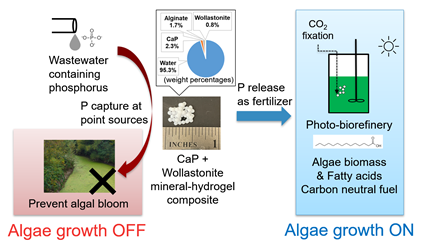Harmful algal blooms (HAB) are a major environmental concern that often appears in eutrophic aquatic systems. To mitigate HABs, this study developed co-mineral seeded hydrogel composites
1,2 that included calcium phosphate (CaP) and wollastonite to recover phosphorous (P) from P-rich water. The applications of CaP + wollastonite mineral-hydrogel composites can reduce the P concentrations to as low as 0.31 mg/L, which is lower than a typical wastewater treatment plant effluent (1-2 mg/L regulatory maximum concentration). The P removal strategy was confirmed to mitigate natural algae community growth. Using fast-growing cyanobacterium
Synechococcus elongatus 2973 as a model microalgae,
3,4 we found that the mineral-hydrogel composites captured up to 92% of the dissolved P in synthetic wastewater (BG11 medium), reducing the biomass growth rate by up to 73% and the total biomass concentration by 75% in treated BG11 medium. If applied to municipal wastewater and agricultural run-off water, the composites removed 96% and 91% of dissolved P, respectively. When simulating the release to a large water body, we observed up to 71% algal growth reduction.
Moreover, the P-recovered composites can be reused as a slow-release bio-compatible fertilizer to support algal growth and promote lipid accumulation without interfering with photosynthesis. Because the fast-growing cyanobacterium S. elongates is also a promising chassis for biofuel productions,3 we further investigated the compositesâ P delivery capability and compatibility with cyanobacterial cultivations. The compositesâ slow-release property provides a P stress to microalgae and makes them oleaginous. We observed a 377% increase in the fatty acid content in S. elongatus biomass under P-stressed conditions.
Therefore, the mineral-hydrogel composites can function for both harmful algal bloom remediation and algal biofuel nutrient supply (illustrated in Figure 1). In P-rich conditions, the mineral-hydrogel composites can capture P for HAB reduction, while under P-deficient conditions and in contact with algal species, it can continuously release P through the dissolution of the mineral seed. The CaP mineral's solubility and the surrounding aqueous P content determine the switch between these two functions. In supersaturated solutions with respect to hydroxyapatite, the mineral-hydrogel composites will collect P, while in solutions that are undersaturated with respect to hydroxyapatite, the mineral-hydrogel composite will release P. This study is a proof-of-concept for applying mineral-hydrogel composites to treat point sources of P pollution and to subsequently recycle captured P in a facilitated photo-biorefinery production of fatty acid biofuels.
Acknowledgment
This project was funded by the United States Environmental Protection Agency (grant number 840084).
Figure 1: Proposed P management framework enabled by novel CaP + wollastonite mineral-hydrogel composites. Depending on the application strategies, the composites can limit or encourage algae growth.


